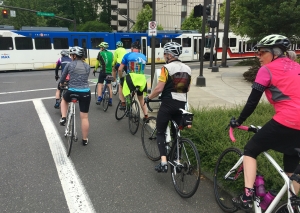Safety: Navigating Intersections
 Safety. Remember the word. Now that we can legally be our lawless selves at stop signs and flashing reds, there is more cause to be alert. Oregon law still requires cyclists to stop and wait at red lights; and additionally it is good not only at solid red lights to be cautious but also at green lights. The excerpt below from the book The Art of Cycling by Robert Hurst offers concerns we can read in print, reflect upon, and consider implementing. Each time we ride, we must be aware of these potential variables:
Safety. Remember the word. Now that we can legally be our lawless selves at stop signs and flashing reds, there is more cause to be alert. Oregon law still requires cyclists to stop and wait at red lights; and additionally it is good not only at solid red lights to be cautious but also at green lights. The excerpt below from the book The Art of Cycling by Robert Hurst offers concerns we can read in print, reflect upon, and consider implementing. Each time we ride, we must be aware of these potential variables:
RUNNING GREEN LIGHTS
Contrary to popular opinion, when an experienced adult cyclist gets smacked by a car, it is most likely that the cyclist was riding lawfully and predictably at the time. There must be something else, a more important ingredient that keeps riders out of trouble when they sneak through red lights, but somehow turns up missing when the light is green. That critical ingredient is the rider’s own awareness.
Rather than simply cruising through a green light with your eyes glazed over and your head in the proverbial clouds, begin to check all the trouble spots vigilantly and anticipate conflicts before they arise. Anticipate the mistakes of those around you. There are five distinct sources of trouble:
1. Well before reaching the intersection, direct your awareness left and behind for cars that might be preparing to turn right across your path. Bicyclists on sidewalks or sidepaths are less likely to be seen and less likely to be respected if they are seen. Even if the little green man is showing on the walk signal, be prepared to stop completely before entering the intersection to stay out of the way of furious right turners. Right-of-way means nothing. Don’t roll into the intersection without first looking behind you.
2. Check quickly for red-light runners moving quickly from the right and left.
3. Check for wayward pedestrians on the loose, stepping blindly into the street. (See The Problem with Pedestrians, page 100.)
4. As early as possible, give the street ahead a thorough examination in search of left turners. Is that oncoming vehicle going to turn left? There is no reliable way to tell if a vehicle is going to turn at you until it does or doesn’t, so assume it will. Be ready for it. Left turners are particularly dangerous because they often carry a great deal of speed, their turns are often not telegraphed, and in their haste they often fail to notice cyclists. To avoid one you may be forced to veer right or left, speed forward, or stop quickly.
Watching for left turners is important even on little streets, where the only intersections are minor driveways. Whenever a car approaches, going the opposite direction on the same street, consider all the potential vectors the vehicle could reasonably take—driveways, alleys, parking spaces, streets, or straight ahead. A little alarm should go off when you are passing by some kind of parking lot entrance or street on your right just before an oncoming vehicle goes by, because you are crossing through that vehicle’s possible path. Avoid these little moments of potential disaster by watching well ahead and subtly adjusting speed and position. This probably sounds excessively cautious to those who don’t have much experience riding in the city. But “driver turns left into cyclist” is an extremely common scenario, and an extremely bloody one as well. A little paranoia is warranted here. You’ll notice nothing is said here about watching for turn signals, except this: turn signals—ha!
5. The cyclist has a little more time to scan the right front for possible right turners. Leave an adequate buffer zone between yourself and any vehicles as you exit the intersection on the far side. Try not to roll right across in front of any bumpers. If you are entering the intersection on a yellow light, be very aware of any overanxious light timers rolling up in the right lane of the intersecting street.
So, let’s see . . . that’s two different types of right turners, in addition to the left turners, light runners, and wayward pedestrians. Every busy intersection is a green garden of mistakes. Two forces need to be balanced when riding through all busy intersections: the instinct to leave space on the left and the instinct to leave space on the right. Both instincts are correct (Hurst, 2007, pp. 89-91).
I know this sounds like your mother cautioning you, “Don’t do that, or you will break your neck.” But really? Safety should become a large part of your DNA.
Enjoy SAFETY,
Mike Heffernan, Member at Large
Reference: Hurst, Robert (2007). The Art of Cycling. Globe Pequot Press. pp 89-91.
